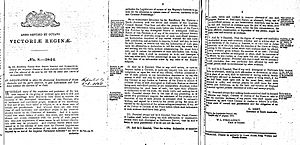Aboriginal Witnesses Act facts for kids
The Aboriginal Witnesses Act was a set of laws and changes made in South Australia a long time ago. These laws were put in place by Lieutenant Governor George Grey when Australia was first being settled by Europeans. The main goal of the Act was to make it easier for Aboriginal people to give evidence in court, even if they didn't take an oath (a special promise).
However, the Act actually made things harder. It created a situation where crimes against Aboriginal people, like massacres by European settlers, could not be proven in court if the only witnesses were Aboriginal people. This meant that a white person could not be found guilty based only on what an Aboriginal witness said.
Understanding the Act's History
Lieutenant Governor George Grey first created this Act. Later, Lieutenant Governor Frederick Robe made some changes to it. The Act said it wanted to allow "uncivilised people" (meaning Aboriginal people at the time) to give evidence in court without swearing an oath.
But there was a big problem. The Act also allowed a judge to decide that an Aboriginal person's evidence was not enough on its own. This meant that a white person could not be found guilty of a crime based only on what an Aboriginal witness said. Even though it seemed like a step forward for its time, the Act left it up to the judge or jury to decide how believable the Aboriginal evidence was. Also, Aboriginal evidence could not be used in trials where someone could be sentenced to death.
How the Act Affected Justice
Because of this Act, it became very difficult to get justice for Aboriginal people. It meant that the murder and massacres of Aboriginal Australians by European settlers often went unpunished. This was because the law made it hard to convict a white person based only on Aboriginal testimony.
For example, after a terrible event called the Avenue Range Station massacre, where several Tanganekald women, children, and an old man were killed, the Act was changed. In July 1849, an amendment was made to allow a person to be found guilty based only on an Aboriginal person's evidence. However, this rarely happened in practice. The Act stayed in force for a very long time, until 1929.
See also
- Aboriginal Cultural Heritage Act 2003
- Aboriginal Heritage Act 1988
- Aboriginal Heritage Act 2006
- Aboriginal Lands Act 1995
- Aboriginal Land Rights Act 1976
- Aboriginal Protection Act 1869
- Australian heritage law
- Half-Caste Act
- Native Title Act 1993


